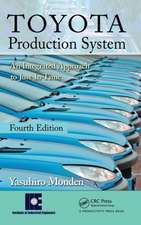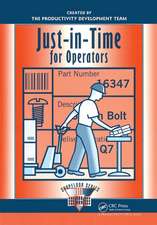Reorganizing the Factory: Competing Through Cellular Manufacturing
Autor Nancy Hyer, Urban Wemmerloven Limba Engleză Hardback – 22 oct 2001
Winner of the 2003 Shingo Prize!
Reorganizing work processes into cells has helped many organizations streamline operations, shorten lead times, increase quality, and lower costs. Cellular manufacturing is a powerful concept that is simple to understand; however, its ultimate success depends on deciding where cells fit into your organization, and then applying the know-how to design, implement and operate them.Reorganizing the Factory presents a thoroughly researched and comprehensive "life cycle" approach to competing through cellular work organizations. It takes you from the basic cell concept and its benefits through the process of justifying, designing, implementing, operating, and improving this new type of work organization in offices and on the factory floor.
The book discusses many important technical dimensions, such as factory analysis, cell design, planning and control systems, and principles for lead time and inventory reduction. However, unique to the literature, it also covers in depth the numerous managerial issues that accompany organizing work into cells. In most implementations, performance measurement, compensation, education and training, employee involvement, and change management are critically important. These issues are often overlooked in the planning process, yet they can occupy more of the implementation time than do the technical aspects of cells.
Includes:
- Why do cells improve lead time, quality, and cost?
- Planning for cell implementation
- Justifying the move to cells, strategically and economically
- Designing efficient manufacturing and office cells
- Selecting and training cell employees
- Compensation system for cell employees
- Performance and cost measurement
- Planning and control of materials and capacity
- Managing the change to cells
- Problems in designing, implementing, and operating cells
- Improving and adapting existing cells
- Structured frameworks and checklists to help analysis and decision-making
- Numerous examples of cells in various industries
Preț: 930.01 lei
Preț vechi: 1134.16 lei
-18% Nou
Puncte Express: 1395
Preț estimativ în valută:
177.98€ • 183.86$ • 148.12£
177.98€ • 183.86$ • 148.12£
Carte tipărită la comandă
Livrare economică 25 martie-08 aprilie
Preluare comenzi: 021 569.72.76
Specificații
ISBN-13: 9781563272288
ISBN-10: 1563272288
Pagini: 788
Dimensiuni: 178 x 254 x 45 mm
Greutate: 1.56 kg
Ediția:1
Editura: Taylor & Francis
Colecția Productivity Press
Locul publicării:Oxford, United Kingdom
ISBN-10: 1563272288
Pagini: 788
Dimensiuni: 178 x 254 x 45 mm
Greutate: 1.56 kg
Ediția:1
Editura: Taylor & Francis
Colecția Productivity Press
Locul publicării:Oxford, United Kingdom
Public țintă
Professional and Professional Practice & DevelopmentRecenzii
"The book will serve as a field-guide for companies who are looking to increase thruput, decrease cost, reduce inventories and leadtimes. Many books I have read have merely touched upon the subject of cellular manufacturing, which on the surface appears to be an easy concept to grasp. However, as any brown field practitioner will tell you, cell implementation is destined for failure or mediocre results without an understanding of the cultural and systemic changes required to enable and sustain the gains. In Reorganizing the Factory, Hyer and Wemmerlöv have decoded the DNA of cellular manufacturing to ensure maximum results and sustainability."
Don Gogan, Plant Manager, Harley-Davidson Motor Company 06/01/04
"There is a new book,Reorganizing the Factory ,that makes "Learning to See" and "Value Stream Mapping" dated! Reorganizing the Factory is a great hands-on book with hardly any fluff! Buy it, read it, and embark on your "lean journey."
Shahrukh Irani, Associate Professor, The Ohio State University 06/01/04
"This is a must read for organizations who want to use Cellular Manufacturing to gain competitive advantage. In addition to "hard" cell design issues, the book focuses as well on the "soft" side of cells, which we have found to be the largest determinants of the success (or failure) of cells."
Michael Wayman, General Manager-Steel Operations, Ingersoll Cutting Tools 06/01/04
"Reorganizing the Factory is a great handbook for a manager either just starting to investigate cells or someone experienced with cells and looking to upgrade/enhance. It also addresses the "soft" side of implementing cells as well as the technical and logistical aspects. In addition, Hyer & Wemmerlöv discuss setting up office cells. Many companies don't realize the large potential benefits of going "cellular" in the office as well as on the manufacturing floor."
Ronald Leong, Manager-Global Business Planning, Delphi Automotive Systems 06/01/04
"This is a well thought-out book based on years of research on implementation of manufacturing cells. The authors have brought the same level of rigor that they are known for in research circles towards writing this book for the benefit of practitioners. It is well-structured, and addresses all relevant design and implementation issues, as well as potential roadblocks in the application of cells. It clearly belongs on the bookshelf of every manufacturing manager interested in streamlining manufacturing operations and supply chains."
Nallan Suresh, Professor, SUNY-Buffalo 06/01/04
Don Gogan, Plant Manager, Harley-Davidson Motor Company 06/01/04
"There is a new book,Reorganizing the Factory ,that makes "Learning to See" and "Value Stream Mapping" dated! Reorganizing the Factory is a great hands-on book with hardly any fluff! Buy it, read it, and embark on your "lean journey."
Shahrukh Irani, Associate Professor, The Ohio State University 06/01/04
"This is a must read for organizations who want to use Cellular Manufacturing to gain competitive advantage. In addition to "hard" cell design issues, the book focuses as well on the "soft" side of cells, which we have found to be the largest determinants of the success (or failure) of cells."
Michael Wayman, General Manager-Steel Operations, Ingersoll Cutting Tools 06/01/04
"Reorganizing the Factory is a great handbook for a manager either just starting to investigate cells or someone experienced with cells and looking to upgrade/enhance. It also addresses the "soft" side of implementing cells as well as the technical and logistical aspects. In addition, Hyer & Wemmerlöv discuss setting up office cells. Many companies don't realize the large potential benefits of going "cellular" in the office as well as on the manufacturing floor."
Ronald Leong, Manager-Global Business Planning, Delphi Automotive Systems 06/01/04
"This is a well thought-out book based on years of research on implementation of manufacturing cells. The authors have brought the same level of rigor that they are known for in research circles towards writing this book for the benefit of practitioners. It is well-structured, and addresses all relevant design and implementation issues, as well as potential roadblocks in the application of cells. It clearly belongs on the bookshelf of every manufacturing manager interested in streamlining manufacturing operations and supply chains."
Nallan Suresh, Professor, SUNY-Buffalo 06/01/04
Cuprins
1. Competing through Cellular Manufacturing2. A Closer Look at Cells: What They Are and the Forms They Take3. Why Cells Improve Performance4. The Planning and Implementation of Cellular Manufacturing Systems5. Factory Planning6. Detailed Planning -- One Cell at a Time7. Understanding Cell Performance Using Modeling8. Determining the Economic Value of Cells9. Performance Measurement for Cells10. Cost Accounting and Cellular Manufacturing11. Manufacturing Planning and Control Systems for Cells12. Job Design and Daily Work in Manufacturing Cells13. Selecting and Training Cell Employees14. Compensation Systems for Cell Employees15. Planning for Cell Implementation and Managing the Change16. Common Problems in the Design, Justification, Implementation and Operation of Cells17. Improvement and Evolution of Cells18. Reorganizing Office Work Using Cellular Principles19. Future Changes and ChallengesAppendices.










